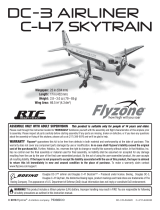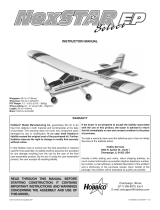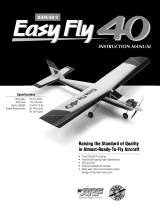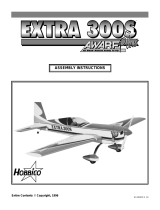Page is loading ...

AIRPLAINE
WITH RADIO CONTROLLER
Model
92304
ASSEMBLY & OPERATING INSTRUCTIONS
Visit our website at: http://www.harborfreight.com
Read this material before using this product.
Failure to do so can result in serious injury.
SAVE THIS MANUAL.
Copyright
©
2004 by Harbor Freight Tools
®
. All rights reserved. No portion of this manual or any artwork con-
tained herein may be reproduced in any shape or form without the express written consent of Harbor Freight
Tools. Diagrams within this manual may not be drawn proportionally. Due to continuing improvements, actual
product may differ slightly from the product described herein. Tools required for assembly and service may not
be included.
For technical questions or replacement parts, please call 1-800-444-3353.
IMPORTANT:
If damage is caused due to a crash, your warranty is void.
Revised Manual 09k

SKU 92304 For technical questions, please call 1-800-444-3353. Page 2
THANK YOU for choosing a HARBOR FREIGHT TOOLS product. For future reference, please
complete the owner’s record below:
Model______________ Serial No._____________ Purchase Date_______________
SAVE THE RECEIPT, WARRANTY AND THESE INSTRUCTIONS. It is important that you read the
entire manual to become familiar with the unit BEFORE you begin assembly.
Technical Specifications
Safety Warnings and Precautions
WARNING: When using product, basic safety precautions should always be followed to
reduce the risk of personal injury and damage to equipment.
Read all instructions before using this product!
1. Store idle equipment. When not in use, the Airplane must be stored in a dry location to inhibit
damage from moisture and salt air.
2. Check for damaged parts. Before using the Airplane, any part that appears damaged should
be carefully checked to determine that it will operate properly and perform its intended function.
Check for any broken or damaged parts and any other conditions that may affect its operation.
Replace or repair damaged or worn parts immediately. Do not use the Airplane if any part is
damaged or broken.
3. Replacement parts and accessories. When servicing, use only identical replacement parts.
Use of any other parts will void the warranty.
4. For ages 16 and over. Do not let children use the Airplane without adult supervision.
Failure to do so could result in personal injury and/or property damage.
Overall Dimensions: 23” L x 31-1/4” W x 5” H (Tail/Wing Tips)
Flight Time: Approximately 20 minutes
Flight Range: 1, 640 Feet
Wing Dimensions: Front = 31-1/4” span x 4” Wide
Tail Wing: 12” Span x 2-1/4” Wide
Fuselage Dimensions: 8-1/8” L x 1-1/2” W x 2-1/4” H
Landing Gear: 2-1/2” H x 4-1/4” W
Wheels: 3/4” diameter x 1/8” Wide
Propellers: 4” L x 1/2” W (30 degree pitch); Pusher type with
7/16” L x 7/16” diameter Nose Cone.
Power Supply: Airplane- 4 cell 4.8V Ni-Mh rechargeable batteries
Transmitter requires (8) “AA” batteries (not included)
Charger: AC/DC
Adapter: Input: 120 V AC; Output: 6.0V DC
Transmitter Frequency: 27 MHz
Weight: 1.7 Lbs.
The “V” shaped elevator acts as both rudder and elevator.
REV 08k; 09j

SKU 92304 For technical questions, please call 1-800-444-3353. Page 3
5. Keep your work area clean and well lit. Cluttered benches and dark areas invite accidents.
6. Always check hardware and assembled parts after assembling. All connections should be
tight and hardware tightened.
7. Dress properly. Wear restrictive hair covering to contain long hair.
8. Use eye protection. Always wear ANSI approved impact safety goggles when assembling and
using this product.
9. Use the right Airplane and components. There are certain applications for which this
Airplane was designed. Do not modify this Airplane and do not use this Airplane for a purpose
for which it was not intended.
10. Do not use or assemble the Airplane if under the influence of alcohol or drugs. Read
warning labels on prescriptions to determine if your judgement or reflexes are impaired while
taking drugs. If there is any doubt, do not assemble or use the Airplane.
11. Do not pick up the Airplane while it is in motion.
12. Use only Batteries of the type recommended.
13. Do not mix old and new batteries.
14. Remove batteries if the Airplane is not used for a long period of time.
15. Make certain to use the Airplane in a large area free from interference from trees,
electrical power lines and other obstacles. If two airplanes with the same frequency are
used (both with the same numbers on the transmitter and/or receiver) they must be at
least 1640 feet away from one another.
16. Never fly near buildings, cars or busy streets.
17. Do not fly the Airplane at or near other people or animals.
18. Keep this product away from small children; small parts can be easily swallowed.
WARNING: The warnings, cautions, and instructions discussed in this instruction manual cannot
cover all possible conditions and situations that may occur. It must be understood by
the operator that common sense and caution are factors which cannot be built into
this product, but must be supplied by the operator.
Unpacking
When unpacking your Airplane with Radio Controller, check to make sure the parts listed on the
next page are included. If any parts are missing or broken, please call HARBOR FREIGHT TOOLS
at 1-800-444-3353.
PLEASE READ THE FOLLOWING CAREFULLY
THE MANUFACTURER AND/OR DISTRIBUTOR HAS PROVIDED THE PARTS DIAGRAM IN THIS
MANUAL AS A REFERENCE TOOL ONLY. NEITHER THE MANUFACTURER NOR DISTRIBUTOR MAKES ANY
REPRESENTATION OR WARRANTY OF ANY KIND TO THE BUYER THAT HE OR SHE IS QUALIFIED TO MAKE
ANY REPAIRS TO THE PRODUCT OR THAT HE OR SHE IS QUALIFIED TO REPLACE ANY PARTS OF THE
PRODUCT. IN FACT, THE MANUFACTURER AND/OR DISTRIBUTOR EXPRESSLY STATES THAT ALL REPAIRS
AND PARTS REPLACEMENTS SHOULD BE UNDERTAKEN BY CERTIFIED AND LICENSED TECHNICIANS
AND NOT BY THE BUYER. THE BUYER ASSUMES ALL RISK AND LIABILITY ARISING OUT OF HIS OR HER
REPAIRS TO THE ORIGINAL PRODUCT OR REPLACEMENT PARTS THERETO, OR ARISING OUT OF HIS OR
HER INSTALLATION OF REPLACEMENT PARTS THERETO.
REV 03/05; 10/05

SKU 92304 For technical questions, please call 1-800-444-3353. Page 4
Assembly/ Operation
Your Airplane with Radio Controller will require complete assembly. It is important that you read the
entire manual to become familiar with the product BEFORE you use the Airplane. Before assembling the
Airplane be sure that you have all parts described in the Parts List and Assembly Diagram, below.
REV 12/04; 03/05; 04/05; 05/05; 10/05; 12/05
NOTE: Some parts are listed and shown for illustration purposes only, and are not available
individually as replacement parts.
Assembly and Parts Diagram
Parts List
Part Description Qty Part Description Qty Part Description Qty
1a Main Wing 1 6 Landing Gear 1 13 Rechargeable Battery Pack 1
1b Tail Wing 1 7 Motor Housing* 2 14 Wing Mount Screws 2
2a Fuselage 1 8 Motor Housing Screw 4 15 Landing Gear Brace 1
2b Lower Motor Housing* 1 9 Receiver 1 16 Wire Antenna 1
3 Canopy 1 10 Remote Control 1 17 Ribbon 1
4
Propeller
(2 spares included)
4 11
Crystal Set
(Transmitter and
Receiver)
1
18 Tail Wing Screws 2
A
*Motor Housing Set
(Contains Part 2b & Part
7x2)
-
5 Motor 2 12 Charger 1
19 Tail Wing Support Brace 1
19
Tail Wing Bracket

SKU 92304 For technical questions, please call 1-800-444-3353. Page 5
Landing Gear Assembly
1. Push Landing Gear (6) into the slot located under the front of the Fuselage (2a) - see Figure 2.
2. Insert the Landing Gear Brace (15) into the Fuselage (2a) at the center of the Landing Gear
(6). The Brace (15) has a tab that fits only one way into the Fuselage - see Figure 2, inset.
Battery Charging
1. Plug the Battery Pack (13) into the Charger (12). Plug the Charger (12) into a 120V
electrical outlet. Allow up to three hours for the initial charge. Do not leave unattended
when charging. Disconnect the Battery Pack (13) from the Charger (12) when the charge is
complete-see Figure 4. The batteries will become warm when they are ready for use. If you
feel them becoming overly hot, immediately disconnect the Charger (12).
2. Make certain that the “ON/OFF” Switch for the Airplane is in the “OFF” position. Plug the
Battery Pack (13) into the socket located underneath the Canopy (3). Insert the battery Pack
(13) into the Fuselage (2a) and close the Canopy (3).
3. Remove cover and insert eight “AA” batteries (not included) into the Remote Control (10).
Switch “ON” the “ON/ OFF” Switch on the Remote Control (10).
Wing, Motor and Propeller Assembly
1. Remove the Screws (8) on the Motor Housings (7). Remove the Motor Housings.
2. Attach the Main Wing (1a) to the Fuselage (2a) and thread in Screws (14) - see Figure 1.
3. Insert Motor (5) into each Motor Housing (7). Put the Motor Housing back together again
and replace the Screws (8). Make certain that the assembly is secured and that the Motors
(5) are tightly in place. Make sure that wiring is inside fuselage and does not get pinched
inside any connections or interfere with the proper fit of any parts.
4. Locate both Propellers (4). Place each Propeller (4) onto the shaft of each Motor (5).
5. Set the Tail Wing (1b) into the Tail Wing Bracket (refer to page 4). Place the Tail Wing
Support Brace (19) on top of the Tail Wing (1b) then insert two Screws (18) through the Tail
Wing Support Brace (19) and the Tail Wing (1b) then screw them in.
Set out all parts on a clear and level surface prior to assembly.
REV 12/04; 03/05; 05/05; 10/05; 12/05; 05/06
Motor Housing
Screws (8)
Wing Mount
Screws (14)
Propeller (4)
Figure 1
Landing
Gear (6)
Figure 2
Landing
Gear
Brace (15)
IMPORTANT:
If damage is caused due to a crash, your warranty is void.

SKU 92304 For technical questions, please call 1-800-444-3353. Page 6
Setting up The Controls
1. Tie the Ribbon (17) to the end of the antenna, as shown in Figure 3.
2. Make certain that your hands are clear of the Propellers and any moving parts. Turn on the
switch on the Airplane.
3. If both trims are adjusted properly, the Propellers (4) should be still when the Airplane is initially
turned “ON”.
4. Each control stick has a Trim Adjustment next to it, as shown to the right.
This is used to fine-tune the neutral position of the control.
5. Pulling downward on the left hand control stick (see Figure 3) will cause
the Propellers (4) to spin faster. Returning the left hand control stick to the
center position should stop both Propellers (4) from spinning if both trims
are adjusted correctly.
6. If neither of the Propellers stop spinning when the left hand control stick
is in the center position, you will have to adjust the left hand trim slowly,
just until one of the propellers stop. The propellers should start spinning
when the control stick is moved even slightly, if not then the left hand trim
is adjusted too far.
7. The right hand control stick controls the left and right Propellers (4). Move the control stick
right to speed up the left Propeller (4), turning right; and left to speed up the right Propeller
(4), turning left. When the control stick is in the center position, neither Propeller (4) should be
spinning.
8. If one of the propellers still spins while both sticks are released, then adjust the right hand trim
until both propellers are stationary. If the left hand trim was not adjusted properly, the propellers
may still spin and steps 5-7 should be repeated until the controls operate the plane reliably.
9. Practice these steps until you are comfortable activating the Propellers (4).
10. To steer the Airplane, move the right hand control stick to the left to steer to the left, and right to
steer it right. Move the right hand control stick slightly to adjust for minor changes in direction
and tilt of the Airplane.
11. The reverse toggles can be used to reverse the operation of each of the control sticks. Each
reverse toggle controls the Control Stick nearest it. There are two settings: “N”=Normal
Operation; “R”=Reversed Controls (left=right, forward=backward, and vice-versa).
Control
Stick
Trim
Adjustment
Left Hand
(Throttle) Controls
Left-hand
control stick
Right-hand
control stick
“On/Off”
Figure 3
Battery
indicator light
Remote Control (10)
Left-hand
trim
Right-hand
trim
Reverse
toggles
Battery Pack (13)
Charger (12)
Plug Battery Pack (13)
into Charger (12)
Figure 4
REV 03/05

SKU 92304 For technical questions, please call 1-800-444-3353. Page 7
Operating and Flying the Airplane
1. Choose a day when the wind is light. The Ribbon (17) attached to the Remote Control antenna
should be blowing slightly (not greater than 30 degrees) and not be blowing straight out. Find
a wide-open field.
2. Face the Airplane into the wind. Move the left hand control stick all the way down so that both
motors are running at full power.
Note: It is recommended that two people work together to hand launch the Airplane. One
should control the Remote Control and one will launch the Airplane.
3. With the Airplane tilted at about 10 degrees, propel and release it into the wind.
4. Let the Airplane climb to and fly at about 50 to 300 feet high. By moving the right and left
control sticks you can change speed and direction.
5. If the Airplane rises too slowly, or dives, it indicates that the Nose is too tight. Adjust for this
by tightening the front Tail Wing Screw and loosening the rear Tail Wing Screw.
6. To steer the Airplane, move the right transmitter control stick to the left to steer to the left, and
right to steer it right. Move the right control stick slightly to adjust for minor changes in direction
and tilt of the Airplane.
7. If the Airplane continues to fly to far right or to far left, correct for it by moving the right transmitter
control the opposite direction. If flying left, move the control right. If flying right, move the control
left.
If adjusting the right control does not work, land the Airplane and adjust the Rudder on the
side it is leaning toward. If leaning left, adjust the left Rudder up slightly. If tilting right, move
the right Rudder up slightly.
8. Note that letting go of the control sticks will automatically bring them to a center position. This
will cause the Airplane to glide, unpowered.
9. Normal flight time for one full charge is about twenty (20) minutes. If the plane appears to be
losing power or climbs with difficulty, the batteries are low. Land the plane.
10. When the remote control’s battery begins to reach the end of its power, the red indicator light will
blink or it will make a warning noise. When this occurs, IMMEDIATELY LAND THE AIRPLANE.
If the remote control’s battery is allowed to die completely, the plane will be uncontrolled
and may cause damage to property or SEVERE PERSONAL INJURY.
11. To bring in the Airplane for landing, glide the Airplane down against the wind. Move the left
control stick toward the center to slow the Propellers (4). Move the right control stick to adjust
for direction. Continue to decrease the Propeller (4) speed and direction until you bring them
to a stop and land the Airplane. If airplane descends too quickly, press slightly harder on the
left control stick to compensate.
REV 03/05
/





